In Faro, My First Visit to the Algarve
In our five previous visits to Portugal, Richard and I had never traveled to the Algarve, that most popular of tourist destinations in the south of the country on the Atlantic coast. We figured that many people had already made their way there, especially tourists from the UK in search of sun and warm weather. Furthermore, as I pointed out in my popular post “Should You Rent a Car in Portugal?” much of the Algarve is only accessible by car.
Faro, the Algarve’s most populous city, is the one exception. Many discount airlines fly directly into Faro, and one can also catch flights there from Lisbon and Porto. Trains and buses go back and forth regularly. Our Intercidades train (aka the slow train) cost around 30 euros each for the round trip and there’s no need for a taxi or shuttle to get into town — it’s right there! The downside of Faro’s accessibility is the constant noise of airplanes; in the summer high season a flight takes off or lands every five minutes. A few weeks before the high season, the interval was 10-15 minutes.
Visitors trade some peace and quiet for cafes, shopping, cultural events, historic buildings, and a restaurant included in the Michelin guide. The city seems to be popular with French tourists, leading my husband to speculate which came first, the Michelin mention or the tourists. (Review forthcoming.) After dinner our first night, we wandered around the Old City, taking pictures of some of the historic buildings at night. Most of these buildings date from the eighteenth and nineteenth centuries and include the City Hall, a bank, and a popular cafe. Another building we visited was an abandoned factory that students and faculty of the Design School of the University of the Algarve have turned into a two-week-long pop-up exhibit of their work. Many of their creations will soon appear in the design stores and tourist shops around the country. And among the works exhibited were children’s book illustrations from Madalena Matoso and Bernardo L. Carvalho, members of the Planeta Tangerina publishing house whose books I’ve translated into English (Lines, Squiggles, Letters, Words and The World in a Second). Unfortunately, the abandoned factory was also home to a large flock of birds that mobilized a Hitchcockian attack on us when I tried to take pictures.
- An old church in Faro
- Inside the church gate.
- The historic City Hall
- A distinguished 19th c. building, now a bank
- A popular cafe in a historic building
The next day, Richard and I took a boat trip through Ria Formosa, the country’s largest wildlife preserve. The trip took us to four islands: Deserta (Desert), Farol (Lighthouse), Armona, and Culatra. The departing planes were an incongruous sight; our guide, Cláudio, explained that the airport was built in the early 1960s three decades before the creation of the wildlife preserve in the 1990s. Before the creation of the wildlife preserve, Deserta was inhabited, but the families were relocated to other islands; we saw new housing on Farol Island for these families. We saw dozens of species of birds (many of them snacking on fish near the shore), oyster farms, and fish of varying shapes and sizes. I pointed out one large enough to be a shark, but Cláudio assured me that no sharks inhabited these waters. He told us how the wildlife preserve helped to restore the population of storks in the Algarve, as the numbers of storks had become dangerously low by 1990 but is now at a healthy level.
When we set out in our boat in the morning, we passed mud banks with crabs scuttling on top of them. By the time we returned, the tide had come in and we crossed open sea — no sign of mud or crabs. As we walked along the beaches of the inlet and the Atlantic Ocean, we saw the gradual progression of the rising tide, though unaware of its effect on the waterway as a whole. I suppose by now you, dear reader, can tell that I live far from the ocean. This may be a well-known process to you, but it was an educational experience for me.
In Culatra, we saw fishing boats moored to the pier, so many that it was hard to find a parking space. These boats of various sizes were designed to fish either in the inlet or the open sea. The larger the boat, the farther out to sea it went. Richard and I met a solo traveler from the north of England, and she joined us for a lunch of grilled fish — though at a different restaurant from the one connected to the tour company. That way, we saved a bit of money and saw a different part of the island, as we walked along pathways in front of fishers’ houses and vacation homes for people living elsewhere in Portugal (which may have been homes belonging to the extended family) or throughout Europe. One of the houses had banners and signs in French.
Chapels of bones — with walls and ceilings made of human bones and skulls — seems to have been popular in Portugal from the Middle Ages to the nineteenth century; these displays were designed to remind worshipers of the transitory nature of life. Faro had such a chapel, which we visited after our boat trip. The bones were worn and cracked, in large part due to the elements in this seaside city, but the walls and ceiling of this chapel were still impressive. On the floor were graves for the city’s religious and political leaders and their family members, dating from the eighteenth to the early twentieth century.
We returned to Lisbon on the train, tired and sunburned, but glad that we finally made the trip to the Algarve and certain that more trips there are in our future.
- Wall of the Chapel of Bones
- Ceiling made of bones and skulls
- Gravestones of two city leaders


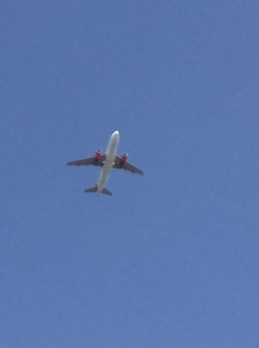
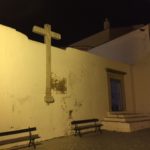
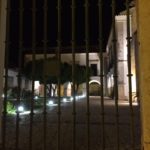
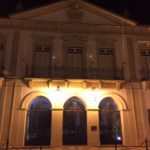
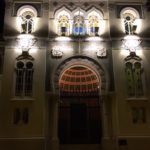
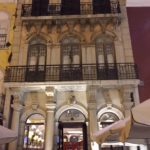
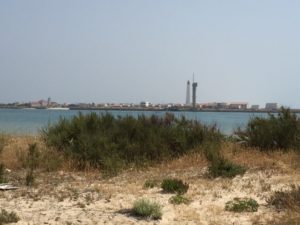
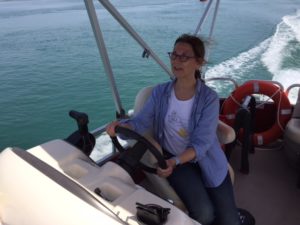
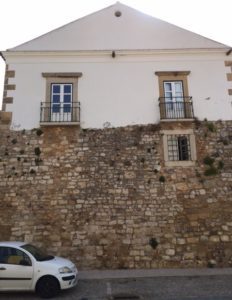
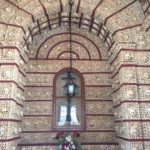
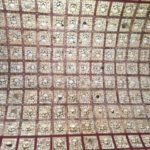
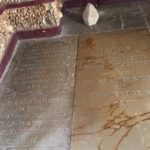





Sounds like a fun excursion. Love the photo of you on the boat. 🙂
Haha! It made me think of the Russian airline pilot who let his kids fly the plane, and they flew it into the side of a mountain.
Dear Lyn, French Tourists surely came first! Friendly, Luís Capucha